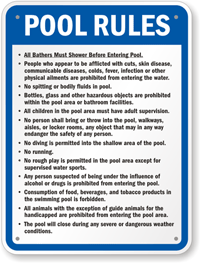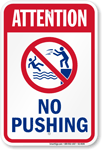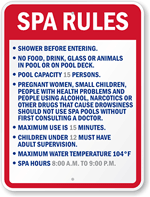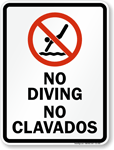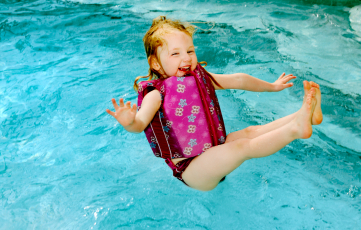 “We Don’t Swim In Your Toilet, So Please Don’t Pee In Our Pool.”
“We Don’t Swim In Your Toilet, So Please Don’t Pee In Our Pool.” A popular sign posted in many public and private pool areas is more necessary than one would think. With record high temperatures exceeding 90 degrees almost every day in the summer on the Eastern coast, public pools are reaching maximum capacity, causing an upsurge in the amounts of bacteria in the pools. Everyone is in a rush to stay cool and hydrated during the long summer days. Nevertheless, this doesn’t mean you should ignore the health risks involved, ones more serious than you may be aware of.
Everyone knows the importance of showering after swimming in a pool. However, not showering prior to entering the pool is the true sin. Studies show that 94% of waterborne diseases are extracted from unsanitary swimming pools, yet only 26% of parents thought it was necessary to bathe their children before entering a public pool. Those statistics don’t look too promising. Pool visitors often fail to wash off substances such as make-up, sunblock, or bug screen that mix with the pool’s disinfectants including
Chlorine. Those entering the pool before rinsing are turning the water “toxic,” causing the decontaminators to be ineffective.
Ranking in second as America’s most popular sport after walking, swimming is a universal activity worldwide whether recreational or competitive. Most individuals are going to enter a swimming pool at least once in their lifetime. Yet, most are oblivious towards the fatal and chronic viruses and bacteria “floating” in these pools that cause what doctors have dubbed “recreational water illness” in 10,000 people a year. “Recreational water illness,” which affects more people than drowning, is most commonly caused by a parasite called cryptosporidium, which causes vomiting, diarrhea and abdominal pain from swallowing the contaminated water in pools or water parks. People can expose the swimming water to parasites, when touching animals, going to the bathroom, or changing a diaper without properly cleansing themselves before entering a pool. Because of its long-lasting life of up to seven days, even in well-maintained pools, cases of cryptosporidium have nearly tripled from 2004 to 2008.
The parasite reaches more than just swimming pools and water parks. Beaches with lakes and ponds are also being affected. A study in Texas shows that intestinal viruses were found in over 40% of theses man-made bodies of water. And thus, lakeside beaches are being closed along with other public swimming facilities that don’t meet health codes because of a rise in bacteria level.
Although it is the leading source of “recreational water illness,” cryptosporidium is not the only threat out there. A common bacterium called pseudomonas aeruginosa, which is generated in the same fashion as cryptosporidium, causes swimmer’s ear--irritation in the ear, and fever. The bacterium enters through the hair follicles, an easy feat in a pool full of contaminated water. A research study in New Mexico found 5 out of the 9 pools that were tested harbored the irritating bacterium, causing another termination of recreational swimming and hydration in the heat of the summer.
Two other disease-causing agents are plunging into community pools causing nausea, vomiting and diarrhea. Giardia Lamblia, hidden in 6% of pools tested in Atlanta, and Norovirus, infecting 28% of people who swam in infectious pools, can easily be prevented by following
pre-shower rules and swimming in only properly maintained pools. With one in five adults admitting to urinating in a public pool and 74% of parents ignoring the pre-shower rule, the number of pools that contract the bacteria and viruses will only increase if rules aren’t strictly enforced immediately. According to its respective state’s Department of Health, all public pools are required to post a
Swimming Pool Rules Sign explicitly listing the pool’s rules, which is also the best and most effective way to implement those rules.
Pool safety doesn’t stop at properly rinsing your body to prevent bacteria from entering a pool. Owners need to maintain a safe facility by informing visitors of pool rules and regulations such as
Pool Depth,
Pool Hours, and
Maximum Occupancy, along with surrounding the pool with a gate or fence for protection. In a family pool in California, two twin boys at the age of one tragically drowned due to the absence of a gate enclosing the pool area. Rowdy teenagers are also in danger. Bored teenagers on long summer days often perceive a non-enclosed pool lacking a sign stating its pool hours, as an open invitation to socialize and play around in the prohibited section. A teenager in Portland nearly drowned after trespassing after pool hours with a group of just as curious friends. Help keep these children safe by enforcing rules with
No Lifeguard On Duty,
Adult Supervision, and
In Case Of Emergency Pool Signs.
Swimming pools are intended to be fun places for children to play in in the summer and for parents to enjoy just as much while watching them. And a swimming pool can be that place. But with 10 causes of death by drowning a day and the number of bacteria and viruses found in pools constantly on the rise, people need to take the proper precautions to make and keep it a safe haven for all.



